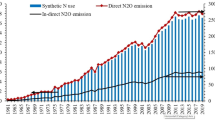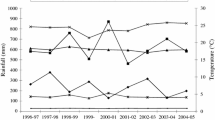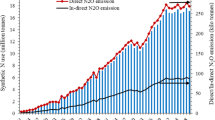Abstract
Wheat–soybean is one of the most dominant cropping systems on the Vertisols of central India. Cultivation of durum wheat in winter season (November to April) has a considerable potential due to congenial climate, while soybean in rainy season (June to October) has witnessed a phenomenal growth in the last two decades in the region. Beside including a legume (soybean) in sequence with a cereal crop (wheat), combined use of available organic sources along with chemical fertilizers may prove beneficial for long-term productivity and sustainability of the system. A long-term experiment was conducted during 1995–2000 on the fine-textured Vertisols at Indore, India to study the effect of combined use of farmyard manure (FYM), poultry manure, vermicompost and biofertilizers (Azotobacter + phosphate solubilizing bacteria) with 0.5 and 1.0 NPK (120 kg N + 26.2 kg P + 33.3 kg K ha−1) on wheat, and residual effect on following soybean. Grain yield of aestivum wheat in the initial 2 years and durum wheat in the later 3 years was significantly increased with 0.5 NPK + poultry manure at 2.5 t ha−1 or FYM at 10 t ha−1 compared with 0.5 NPK alone, and was on par with 1.0 NPK. However, the highest productivity was obtained when these organic sources were applied along with 1.0 NPK. Quality parameters of durum wheat viz protein content, hectolitre weight and sedimentation value showed improvement, and yellow berry content was significantly lower with combined use of NPK + organic sources compared with NPK alone and control. Soybean did not show much response to residual effect of nutrient management treatments applied to wheat. Wheat gave higher profit than soybean, particularly in the later years due to lower grain yields and market price of soybean. However, the superiority of FYM as well as poultry manure along with 1.0 NPK was evident on the overall profitability of the system. Various soil fertility parameters including chemical and biological properties showed conspicuous improvement over the initial status under the treatments of FYM and poultry manure. Sustainability yield index was maximum under 1.0 NPK, followed by 1.0 NPK + poultry manure or FYM. It was concluded that application of available organic sources, particularly FYM and poultry manure along with full recommended dose of NPK fertilizers to wheat was essential for improving productivity, grain quality, profitability, soil health and sustainability of wheat–soybean system.


Similar content being viewed by others
References
Behera UK (2005) Influence of varying levels of soil fertility on performance of kharif soybean (Glycine max) under wheat–soybean cropping system in the vertisols of central India. Ann Agric Res 26(2):263–266
Behera UK, Sharma AR (2004) Effect of tillage and crop establishment practices on performance of soybean. Annual Report, pp. 45. Indian Agric. Res. Instt., New Delhi
Behera UK, Chougule BA, Thakur RS, Ruwali KN, Bhawsar RC, Pandey HN (2000) Influence of planting dates and nitrogen levels on yield and quality of durum wheat. Indian J Agric Sci 70(7):434–436
Bhindhu PS, Gaikwad TS (1998) Sustainability yield index of soybean–wheat cropping system as influenced by land form and soil site characteristics. J Indian Soc Soil Sci 46:86–89
Casida LE, Klein DP, Santora T (1964) Solid dehydrogenase activity. Soil Sci 93:371–376
Hegde DM, Dwivedi BS (1994) Crop response to biofertilizers in irrigated areas. Fertil News 39(4):19–26
Iyamuremye F, Dick RP (1996) Organic amendments and phosphorus sorption by soils. Adv Agron 56:139–185
Jenkinson DS, Powlson DS (1976) The effect of biological treatments on metabolism in soil. VA method for measuring soil biomass. Soil Biol Biochem 8:209–213
Kumar S (1997) Response of durum wheat to N and P fertilization under different sowing dates. Ph.D. Thesis, CCS Haryana Agric. Univ., Hisar, India
Manna MC, Ganguly TK (1997) Soil biological activity and yield of crops as influenced by compost and inorganic fertilizers under a cereal–legume system in a Typic Haplustert. J Soil Biol Ecol 17(2):88–94
Manna MC, Ghosh PK, Ganguly TK (2003) Comparative performance of four sources of enriched phosphocompost and inorganic fertilizer application on yield, uptake of nutrients and biological activity of soil under soybean–wheat rotation. Food Agric Environ 1(2):203–208
Mishra BK, Gupta RK (1995) Protocols for evaluation of wheat quality. Technical Bulletin No. 3, 98 p. Directorate of Wheat Res., Karnal, India.
Nagarajan S, Singh G (1998) Sustaining wheat (Triticum aestivum) revolution – retrospect and prospect. Indian J Agric Sci 68:396–404
Nambiar KKM (2002) Soil fertility and crop productivity under long-term fertilizer use in India. Indian Council Agric. Res., New Delhi.
Nanwal RK, Madan S, Sanjeeb K (1998) Influence of fertilization on yield and quality of macroni wheat (Triticum durum). Indian J Agron 41(2):22–25
Pandey HN, Thakur RS, Bhawsar RC, Ruwali KN, Mishra AN, Verma PK, Behera UK, Singh RB (2000) Role of durum wheat cultivation in Indian wheat economy. Indian Farming 50(8):14–16
Reddy DD, Subba Rao A, Reddy Sammi K, Takkar PN (1999) Yield sustainability and phosphorus utilization in soybean–wheat system on Vertisols in response to integrated use of manure and fertilizer phosphorus. Field Crops Res 62:181–190
Shepherd MA, Withers PJ (1999) Application of poultry litter and triple superphosphate fertilizer to a sandy soil: effect on soil phosphorus status and profile distribution. Nutr Cycl Agroecosyst 54:233–242
Singh RP, Das SK, Rao UMB, Reddy MN (1990) Towards sustainable dryland agricultural practices. Bulletin pp. 5–9. Central Research Institute for Dryland Agriculture, Hyderabad
Smith GP, Gooding MJ (1999) Models of wheat grain quality considering climate, cultivar and nitrogen effects. Agric For Meteorol 94:159–170
Subba Rao A, Muneswar S, Reddy DD, Saha JK, Manna MC, Singh MV (1998) Integrated plant nutrient supply system to improve and sustain the productivity of soybean–wheat cropping system on Typic Haplusterts. Bulletin No. 2, pp. 78–91. Indian Instt. Soil Sci., Bhopal.
Tabatabai MA, Bremner JM (1969) Use of nitrophenyl phosphatase activity for assay of soil phosphatase activity. Soil Biol Biochem 1:301–307
Yadav RL, Prasad K, Gangwar KS, Dwivedi BS (1998) Cropping systems and resource-use efficiency. Indian J Agric Sci 68(8):548–558
Zarco-Hernandez ZA (2005) Durum wheat (Triticum turgidum L.) carrying the 1BL/1RS chromosomal translocation: agronomic performance and quality characteristics under Mediterranean conditions. Eur J Agron 22:33–43
Acknowledgements
Authors express their thanks to Dr. S. Nagarajan, former Director, Directorate of Wheat Research Karnal; Dr. Damodar Reddy and Dr. M.C. Manna, Senior Scientists, Indian Institute of Soil Science, Bhopal; and Dr. S.P. Tiwari, former Director, National Research Centre for Soybean, Indore; and Dr. K.S. Gajbhiye, Director, National Bureau of Soil Survey and Land Use Planning, Nagpur, India for extending help in chemical analysis of the soil and plant samples in their laboratory.
Author information
Authors and Affiliations
Corresponding author
Rights and permissions
About this article
Cite this article
Behera, U.K., Sharma, A.R. & Pandey, H.N. Sustaining productivity of wheat–soybean cropping system through integrated nutrient management practices on the Vertisols of central India. Plant Soil 297, 185–199 (2007). https://doi.org/10.1007/s11104-007-9332-3
Received:
Accepted:
Published:
Issue Date:
DOI: https://doi.org/10.1007/s11104-007-9332-3




